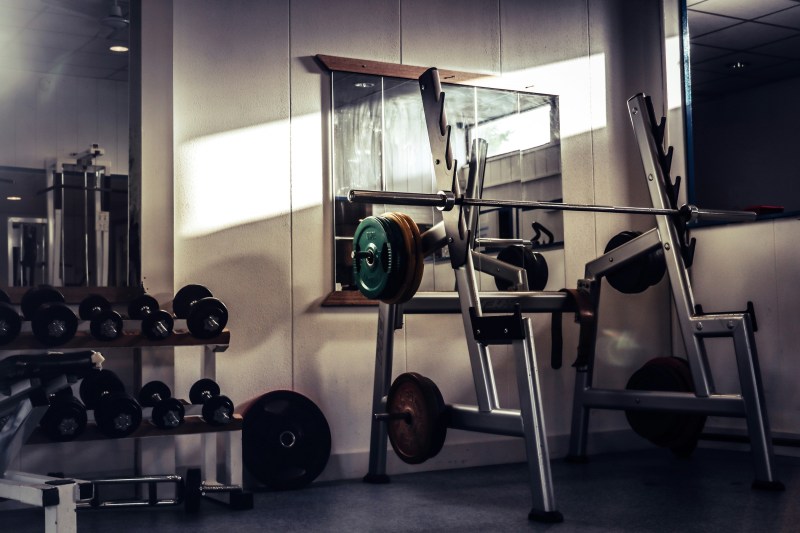Power rack vs. squat rack — which is better? The answer really depends on what exercises are a part of your program and what your overall fitness goals are. Both pieces of equipment have their perks and downsides, but I personally include each of them in my own workout plans.
If you find yourself struggling to pick between the two pieces of equipment when you’re in the gym, keep reading for guidance on when exactly a power rack or a squat rack is the right choice!
What is a power rack, and how does it work?

A power rack, also known as a power cage, is a large, four-post structure used primarily for strength training exercises like squats, bench presses, and overhead presses. It consists of two vertical frames connected by horizontal bars at the top and bottom, creating a cage-like design.
Most power racks include adjustable safety pins or spotter arms that can be set at different heights to catch the barbell if you happen to fail your lift. When using a barbell, you would usually rack it on adjustable J-hooks that allow for a customized starting position depending on the exercise.
Some power racks also come with additional attachments, such as pull-up bars, dip handles, or cable systems, which increase the range of exercises that can be performed. To use a power rack, you would step inside the cage, position the barbell on your back or chest, and lift with the assurance that the safety mechanisms are there to support you if needed.
What is a squat rack, and how is it different?

A squat rack is another piece of strength training equipment, and it is designed to hold a barbell at shoulder height for similar exercises as the power rack, including squats, lunges, and overhead presses.
Unlike a power rack, which features four upright posts and an enclosed design, a squat rack typically has two vertical posts or uprights and often includes a base for added stability. Some squat racks are very minimal, while others — called half racks — include added features like spotter arms or storage pegs. The open design of a squat rack allows for easier access to the barbell and takes up less space, making it popular in both home and commercial gyms.
When using it, position the barbell on the adjustable J-hooks or pegs, and stand in front of the rack to unrack and rack the weight. While squat racks can support a wide range of exercises, they’re primarily used for movements that start from a standing position and don’t require an enclosed space.
Pros and cons of each: Safety, versatility, and space

Power racks
Power racks offer superior safety thanks to their enclosed design and adjustable safety bars, which can catch the barbell during failed lifts. This makes them ideal for solo training, especially with heavy weights. This is important to note, as the Strength and Conditioning Journal shares that “Squatting should be done with one or more spotters if some type of safety rack isn’t used.”
They’re also highly versatile, supporting a wide range of exercises like squats, bench presses, rack pulls, and pull-ups. Some even come with attachments for cable work or dips. However, power racks take up more space and can be expensive, which may not suit smaller home gyms.
Squat racks
Squat racks, on the other hand, are more compact and often more affordable. Their open design makes them easier to move and position, which is great for smaller workout areas. While squat racks can accommodate many of the same exercises, they typically offer less built-in safety and versatility. Spotter arms can be added for some safety, but they don’t match the full support of a power rack. Ultimately, the trade-off is between functionality and footprint.
Which one should you choose for your training goals?

Choosing between a power rack and a squat rack depends on your training goals, available space, and budget. If you’re serious about strength training, want to lift heavy safely, or plan to work out alone, a power rack is the better option. It offers greater exercise variety and built-in safety features, making it ideal for well-rounded programs that include squats, bench presses, and more.
However, if your workouts primarily focus on squats and overhead lifts, and you’re limited by space or budget, a squat rack is a solid choice. It covers the essentials and can still support progression. Consider your long-term goals, how often you train, and whether you’ll need safety features for solo sessions. The right rack should match your current needs, as well as how you plan to grow.
Frequently asked questions

Can you squat in a power rack?
Yes, you can squat in a power rack, and it’s actually one of the safest ways to do so. The adjustable safety bars can catch the weight if you fail a rep, making it ideal for solo training. It also allows for easy setup and precise positioning under the bar.
Are power racks safer?
Power racks are generally safer than squat racks because they have four upright posts and adjustable safety bars that catch the weight if you fail a lift. This enclosed design provides more stability and protection, especially during heavy lifts or solo workouts, making them a popular choice for home gyms.
Can you deadlift in a power rack?
Yes, you can deadlift in a power rack, but it’s not always necessary. Most lifters prefer to deadlift outside the rack for more space. However, using the rack’s safety pins for rack pulls — a deadlift variation that consists of the top portion of the lift — is a common and effective use.




